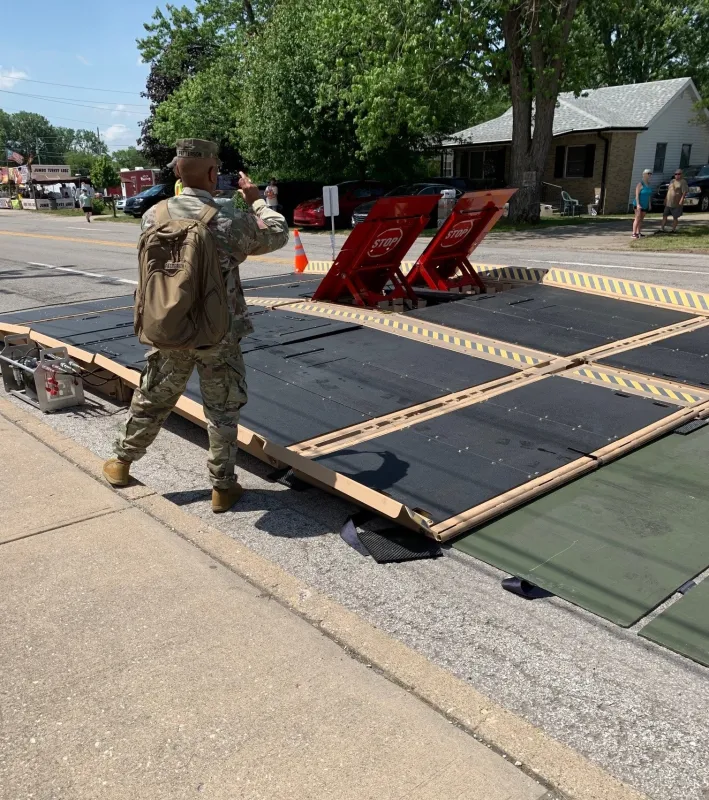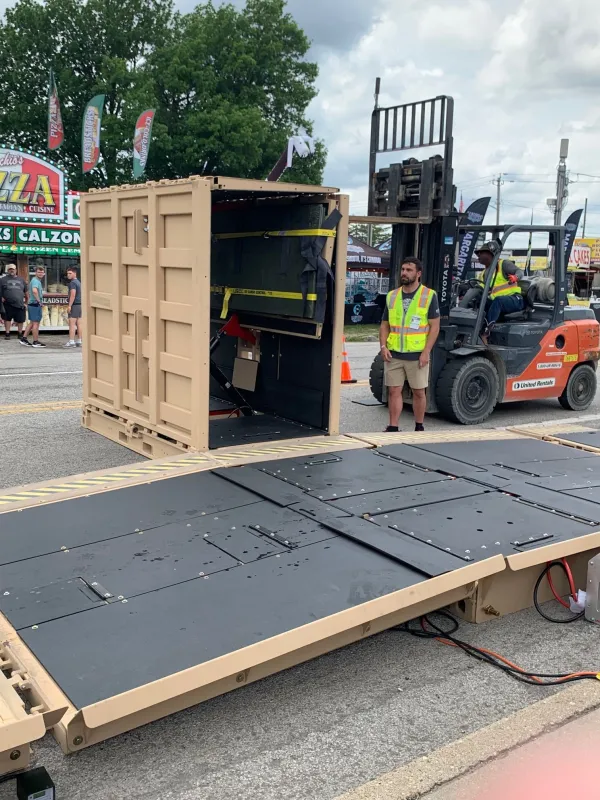The Science and Technology Directorate (S&T), Cybersecurity and Infrastructure Security Agency (CISA), and U.S. Army Engineer Research and Development Center (ERDC) teamed up to deploy a new vehicle barrier at this year’s race. Here’s a peek at how it went and an update on why we were there.

There was something a little different this year at the Indianapolis 500.
In keeping with tradition, the 108th running of the race was held on Memorial Day weekend, and for many fans, it was the unofficial start of summer.
For S&T, it was all business.
On the Friday before the green flag waived, the DETER vehicle mitigation barrier was deployed on Georgetown Road, one of the main thoroughfares adjacent to the Speedway. It was “Carburetion Day,” or “Carb Day,” the final practice before the main event with more than 75,000 fans in attendance. While Georgetown Road is closed to vehicles on race day, Carb Day saw a steady stream of traffic and thousands of pedestrians trying to cross to-and-from the racetrack. It was the perfect venue to put DETER to use.

S&T is evaluating DETER in real-world environments like the Indy 500 and last year’s NFL Draft to identify operational requirements for CISA, and the larger Department of Homeland Security, and federal, state, and local law enforcement. The work is part of S&T’s Critical Infrastructure Security & Resilience Research Program, funded by the Infrastructure Investment and Jobs Act. Large events like these allow S&T to gather valuable data about durability and how the system operates in a real deployment. New modifications were made specifically for this deployment, including hydraulic tuning, widening of the platforms, and new safety enhancements that allowed more than 1,500 vehicles to pass over the barriers.
“DETER would take the place of a jersey barrier—if you want to block off a street effectively, you'd have to forklift jersey barriers in to position,” said S&T Physical Security Program Manager Ali Fadel. “The problem with that is, if an emergency vehicle needs to get through, you still need that forklift to move it out of the way. With DETER, we can lower that same barrier instantly and allow those emergency vehicles to pass. We can also temporarily stop traffic for as long as necessary until law enforcement deems that it is safe for traffic to continue.”

On the scene, ERDC designer August Johnson pointed out a new DETER use. “It's performing a function that I hadn't necessarily thought of before,” he said. “We are using it kind of as a speed bump today, just to slow traffic down that's approaching this intersection where a lot of pedestrians are crossing. I think it's proving very useful in that function as well, slowing down traffic before they get to the intersection where all these folks are trying to get into the raceway."
As part of the demonstration, the vehicle barrier was raised to stop traffic, and in just a matter of seconds, the “speed bump” became a barrier four feet high. Then, a few seconds later, it was lowered and cars and trucks were once again passing over it.

DETER was moved to a different location on race day, demonstrating the versatility of the system as it safeguarded the more than 300,000 fans in attendance as they enjoyed the race weekend activities.
Mr. Fadel stressed that the deployment and testing of DETER at Indy was a great example of agencies working together for a common goal.
“This has been a highly collaborative effort between S&T, the Army Corps of Engineers, as well as DHS components like CISA and even the Transportation Security Administration,” he said. “In addition, our public/private partnership with the Indianapolis Motor Speedway is strong, and they have been very accommodating of our partnership to test DETER in a commercial venue.”
“This kind of R&D partnership is what leads to the idea becoming something that is ready to use. These deployments prove that these concepts work in the real world.”
Listen to S&T’s Tech Speak mini podcast, A Little More Sophisticated Technology, to hear more about DETER from Ali Fadel and August Johnson at the Indy 500. For related media inquiries, contact STMedia@hq.dhs.gov.
